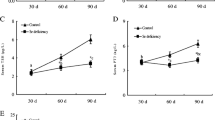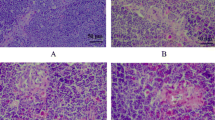Abstract
The purpose of this 42-day study was to investigate the effects of low selenium (Se) on immune function by determining cell cycle and apoptosis of bursa of Fabricius. One hundred twenty 1-day-old avian broilers were randomly assigned to two groups of 60 each and were fed on a low Se diet (0.0342 mg/kg Se) or a control diet (0.2 mg/kg Se), respectively. The relative weight of bursa was significantly decreased in low Se group from 28 days of age in time-dependent manner when compared with that of control group. Cell cycle analysis by flow cytometry showed that low Se caused an increase in G0G1 phase cells that corresponded to a decrease in S phase cells in bursa of Fabricius. Ultrastructurally, mitochondria injury and increased apoptotic cells with condensed nuclei were observed. Low Se increased the percentage of Annexin V-positive cells, as measured by flow cytometry, in comparison with that of control group. These data suggested that low Se diet restrained the development of bursa of Fabricius by cell cycle arrest and apoptosis.




Similar content being viewed by others
References
Hoekstra WG (1975) Biochemical function of selenium and its relation to vitamin E. Fed Proc 34:2083–2089
Nesheim MC, Scott ML (1958) Studies on the nutritive effects of selenium for chicks. J Nutr 65:601–618
Thompson JN, Scott ML (1970) Impaired lipid and vitamin E absorption related to atrophy of the pancreas in selenium-deficient chicks. J Nutr 100:797–809
Spallholz JE (1990) Selenium and glutathione peroxidase: essential nutrient and antioxidant component of the immune system. Adv Exp Med Biol 262:145–158
Turner RJ, Finch JM (1991) Selenium and the immune response. P Nutr Soc 50:275–285
Kiremidjian-Schumacher L, Roy M (1998) Selenium and immune function. Zeitschrift Für ernährungswissenschaft 37(Suppl 1):50–56
McKenzie RC, Rafferty TS, Beckett GJ (1998) Selenium: an essential element for immune function. Immunol Today 19:342–345
Brown KM, Arthur JR (2001) Selenium, selenoproteins and human health: a review. Public Health Nutr 4:593–599
Bhaskaram P (2002) Micronutrient malnutrition, infection, and immunity: an overview. Nutr Rev 60:S40–S45
Marsh JA, Combs GF Jr, Whitacre ME, Dietert RR (1986) Effect of selenium and vitamin E dietary deficiencies on chick lymphoid organ development. P Soc Exp Biol Med 182:425–436
Kiremidjian-Schumacher L, Roy M, Wishe HI, Cohen MW, Stotzky G (1994) Supplementation with selenium and human immune cell functions, II: effect on cytotoxic lymphocytes and natural killer cells. Bio Trace Elem Res 41:115–127
Spallholz JE, Martin JL, Gerlach ML, Heinzerling RH (1973) Immunologic responses of mice fed diets supplemented with selenite selenium. P Soc Exp Biol Med 143:685–689
Spallholz JE, Stewart JE (1989) Advances in the role of minerals in immunobiology. Bio Trace Elem Res 19(3):129–151
Desowitz RS, Barnwell JW (1980) Effect of selenium and dimethyl dioctadecyl ammonium bromide on the vaccine-induced immunity of Swiss-Webster mice against malaria (Plasmodium berghei). Infect Immun 27:87–89
Marsh JR, Dietert RR, Combs GF Jr (1981) Influence of dietary selenium and vitamin E on the humoral immune response of the chick. P Soc Exp Biol Med 166:228–236
Larsen HJ, Tollersrud S (1981) Effect of dietary vitamin E and selenium on the phytohaemagglutination response of pig lymphocytes. Res Vet Sci 31:301–305
Boyne R, Arthur JR (1979) Alterations of neutrophil function in selenium-deficient cattle. J Comp Pathol 89:151–158
Serfass RE, Ganther HE (1975) Defective microbicidal activity in glutathione peroxidase-deficient neutrophils of selenium-deficient rats. Nature 255:640–641
Arthur JR, McKenzie RC, Beckett GJ (2003) Selenium in the immune system. J Nutr 133:1457S–1459S
Cui HM (1988) The histopahologic study of selenium deficiency in chicks. Acta Veterinaria et Zootechnica Sinica 1:52–56
Peng X, Cui Y, Cui W, Deng JL, Cui HM (2009) The decrease of relative weight, lesions, and apoptosis of bursa of Fabricius induced by excess dietary selenium in chickens. Bio Trace Elem Res 131(1):33–42
Cui HM, Fang J, Peng X (2003) Pathology of the thymus, spleen and bursa of Fabricius in zinc-deficient ducklings. Avian Pathol 32:259–263
Gries CL, Scott ML (1972) Pathology of selenium deficiency in the chick. J Nutr 102:1278–1296
Yarrington JT, Whitehair CK (1975) Ultrastructure of gastrointestinal smooth muscle in ducks with a vitamin E-selenium deficiency. J Nutr 105:782–790
Lehmann J, McGill M (1982) Biochemical and ultrastructural alterations in platelets, reticulocytes, and lymphocytes from rats fed vitamin E-deficient diets. J Lipid Res 23:299–306
Pines J (1995) Cyclins, CDKs and cancer. Semin Cancer Biol 6:63–72
Saito Y, Yoshida Y, Akazawa T, Takahashi K, Niki E (2003) Cell death caused by selenium deficiency and protective effect of antioxidants. J Biol Chem 278(41):39428–39434
Zeng H (2002) Selenite and selenomethionine promote HL-60 cell cycle progression. J Nutr 132:74–679
Cheng WH, Quimby FW, Lei XG (2003) Impacts of glutathione peroxidase-1 knockout on the protection by injected selenium against the pro-oxidant-induced liver aponecrosis and signaling in selenium-deficient mice. Free Radical Bio Med 34(7):918–927
Green DR (2000) Apoptotic pathways: paper wraps stone blunts scissors. Cell 102:1–4
Rao L, Puschner B, Prolla TA (2001) Gene expression profiling of low selenium status in the mouse intestine: transcriptional activation of genes linked to DNA damage, cell cycle control and oxidative stress. J Nutr 131:3175–3181
Acknowledgment
This work was supported by Program for Changjiang Scholars and Innovative Research Team in University (IRT 0848) and the Education Department of Sichuan Province (2006A007).
Author information
Authors and Affiliations
Corresponding author
Rights and permissions
About this article
Cite this article
Peng, X., Cui, Y., Cui, W. et al. The Cell Cycle Arrest and Apoptosis of Bursa of Fabricius Induced by Low Selenium in Chickens. Biol Trace Elem Res 139, 32–40 (2011). https://doi.org/10.1007/s12011-010-8639-8
Received:
Accepted:
Published:
Issue Date:
DOI: https://doi.org/10.1007/s12011-010-8639-8




